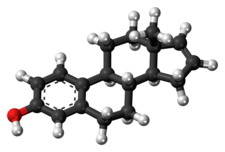Estratetraenol
 | |
 | |
| Clinical data | |
|---|---|
| Other names | Estra-1,3,5(10),16-tetraen-3-ol |
| ATC code |
|
| Identifiers | |
| |
| CAS Number | |
| PubChem CID | |
| ChemSpider | |
| UNII | |
| ChEBI | |
| CompTox Dashboard (EPA) | |
| Chemical and physical data | |
| Formula | C18H22O |
| Molar mass | 254.373 g·mol−1 |
| 3D model (JSmol) | |
| |
| |
| (verify) | |
Estratetraenol, also known as estra-1,3,5(10),16-tetraen-3-ol, is an endogenous steroid found in women[1] that has been described as having pheromone-like activities in primates,[2] including humans.[3][4][5][6] Estratetraenol is synthesized from androstadienone by aromatase likely in the ovaries,[7] and is related to the estrogen sex hormones, yet has no known estrogenic effects. It was first identified from the urine of pregnant women.[8]
Estratetraenyl acetate, or estra-1,3,5(10),16-tetraen-3-yl acetate, is a more potent synthetic derivative of estratetraenol.[9]
Estratetraenol is an estrane (C18) steroid and an analogue of estradiol where the C17β hydroxyl group has been removed and a double bond has been formed between the C16 and C17 positions.
Experiments[edit]
Experiments performed have indicated a correlation between estratetraenol and the ability to attract cooperative mates. The hormone sends olfactory signals of high fertility in pregnant and ovulating women that presents and highlights attractive qualities in those women to potential mates. These interactions between the hormone signals and males showed an increased cooperation and compassion from males to the pregnant female.[10]
Another study shows that the hormone can have an effect on how a male will approach the pursuance of a female by altering the level of sexual cognition and behavior. While the hormone increases the attractions of males to females, studies also show that it does not have an effect on the impulsive sexual nature of men when it relates to sexual desire and delayed gratification.[11]
See also[edit]
References[edit]
- ^ Thysen B, Elliott WH, Katzman PA (January 1968). "Identification of estra-1,3,5(10),16-tetraen-3-ol (estratetraenol) from the urine of pregnant women (1)". Steroids. 11 (1): 73–87. doi:10.1016/S0039-128X(68)80052-2. PMID 4295975.
- ^ Laska M, Wieser A, Salazar LT (May 2006). "Sex-specific differences in olfactory sensitivity for putative human pheromones in nonhuman primates". Journal of Comparative Psychology. 120 (2): 106–112. doi:10.1037/0735-7036.120.2.106. PMID 16719588.
- ^ Jacob S, Hayreh DJ, McClintock MK (2001). "Context-dependent effects of steroid chemosignals on human physiology and mood". Physiology & Behavior. 74 (1–2): 15–27. doi:10.1016/S0031-9384(01)00537-6. PMID 11564447. S2CID 19312085.
- ^ Savic I, Berglund H, Gulyas B, Roland P (August 2001). "Smelling of odorous sex hormone-like compounds causes sex-differentiated hypothalamic activations in humans". Neuron. 31 (4): 661–668. doi:10.1016/S0896-6273(01)00390-7. PMID 11545724. S2CID 2547202.
- ^ Berglund H, Lindström P, Savic I (May 2006). "Brain response to putative pheromones in lesbian women". Proceedings of the National Academy of Sciences of the United States of America. 103 (21): 8269–8274. Bibcode:2006PNAS..103.8269B. doi:10.1073/pnas.0600331103. PMC 1570103. PMID 16705035.
- ^ Berglund H, Lindström P, Dhejne-Helmy C, Savic I (August 2008). "Male-to-female transsexuals show sex-atypical hypothalamus activation when smelling odorous steroids". Cerebral Cortex. 18 (8): 1900–1908. doi:10.1093/cercor/bhm216. PMID 18056697.
- ^ Weusten JJ (1989). Biochemical pathways in human testicular steroidogenesis (PDF) (Ph.D. thesis). Pressa Trajectina.
- ^ Thysen B, Elliott WH, Katzman PA (January 1968). "Identification of estra-1,3,5(10),16-tetraen-3-ol (estratetraenol) from the urine of pregnant women (1)". Steroids. 11 (1): 73–87. doi:10.1016/s0039-128x(68)80052-2. PMID 4295975.
- ^ Lundström JN (2005). Human pheromones : psychological and neurological modulation of a putative human pheromone (Ph.D. thesis). Uppsala: Acta Universitatis Upsaliensis. p. 17. ISBN 91-554-6297-9.
- ^ Oren C, Shamay-Tsoory SG (March 2019). "Women's fertility cues affect cooperative behavior: Evidence for the role of the human putative chemosignal estratetraenol". Psychoneuroendocrinology. 101: 50–59. doi:10.1016/j.psyneuen.2018.10.028. PMID 30408723. S2CID 53217847.
- ^ Wu Y, Wei R, Ou J, Shen B, Ye Y (November 2022). "Estratetraenol increases preference for large sexual reward but not impulsivity among heterosexual males". Hormones and Behavior. 146: 105266. doi:10.1016/j.yhbeh.2022.105266. hdl:10397/95794. PMID 36152381. S2CID 252432682.


 French
French Deutsch
Deutsch